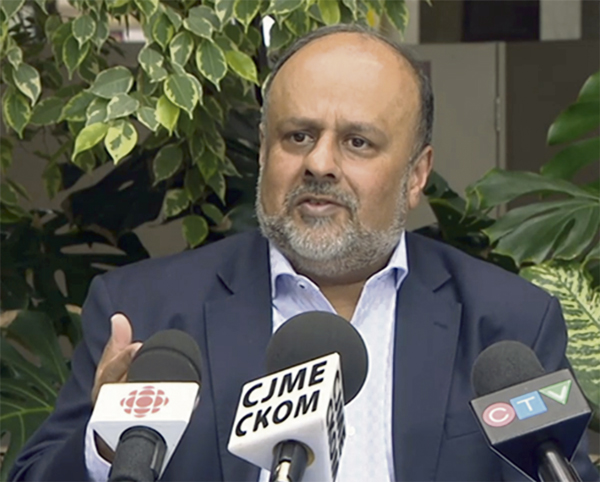Saskatchewan’s chief medical health officer explained on Monday how Saskatchewan got to such a place as to where Phase 3 of the province’s reopen plan could begin on that day.
Dr. Saqib Shahab said that the province is in a safe place regarding the effective reproductive number for the virus.
“Overall in Saskatchewan we are well below one at .64 and that for the north at .76 as well as the south at .63. So these were hard won gains and it is important that we retain them and for the north especially their recent cluster has just now emerged from travel restrictions,”
The travel restrictions in the northwest quadrant of the province were lifted that day. He explained that in the first week of April the province was at an effective reproductive number of two and the north was at 3.3.
That means that in the first week of April, each infected resident was infecting two others across Saskatchewan, and while in the north each was infecting an average of 3.3 others. Rates below one mean each infected resident spreads the virus to less than one other person and chains of transmission break.
“So we were effectively in an exponential growth. And then in Saskatchewan the north had a significant cluster towards the end of April and early part of May and it also has now gone below one. The red line is below one,” Shahab said.
As has become a common theme for Shahab, he emphasized that the great work the people of the province have done has got Saskatchewan to that position.
“We have to remember this is recent history in the last eight weeks and so while we make gains to move ahead and should move ahead safely. We have to remember that what we have gone through in the recent past,” Shahab said.
As recently as the middle of March most cases were travel-related, Shahab said.
“Then we had for the vast majority of travel cases and some transmission due to large gatherings,” he said.
Earlier, the province was also doubling cases every two to three days in locations like Regina and Saskatoon.
“In March and April, our case numbers are doubling every two to three days and we were in a very concerning trajectory, this is recent history and then of course on the end of April (beginning of ) May our case doubling has gone down and is now down to 35 days. These are hard won gains done through a lot of sacrifice and different way of leading a life by all of us.”
In March, Saskatchewan put a number of restrictions including school closures and businesses shutting down.
“In some ways this was really hard for the economy, really hard for individuals, in some ways a difficult decision for government for sure,” he said.
With gathering sizes increasing to 15 indoors and 30 outdoors in phase three he explained how gathering size is a key element of modeling.
“Our mathematical modeling has shown that if your gathering number is small and it is local it is like kindling and when it catches fire it burns out because it is small and 20 to 30 seems to be the sweet spot,” Shahab said.
According to Shahab, the move to 30 people outdoors was undertaken very cautiously.
“That starts pushing that envelope for more rapid transmission but that is where we are and repeated models and actual data shows the larger the gathering size, the more rapid the transmission and we saw that in the early part of March.”
In early March there were large transmission events such as the medical conference and the snowmobile rally and other community events.
“We can’t forget that recent history and quickly without a lot of thought go to large gatherings, even if we go to gatherings larger than 15 indoors and 30 outdoors we really need to think through how can we do that in a different way, how can we maybe continue to have indoor cohorts of 15 maybe in separate rooms,” Shahab said.


